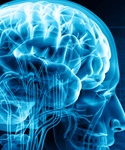Deep brain stimulation (DBS) surgery is a procedure in which electrodes are implanted into specific brain structures and connected to a pacemaker. DBS has been used effectively to treat several neurologic conditions, including Parkinson’s disease. Several companies have developed DBS systems, one of the newest being the ClearPoint Neuro Intervention System (MRI Interventions). The ClearPoint system offers several benefits to patients who are being considered for DBS and to surgeons performing the procedure.
New DBS System Enables Real-Time Visualization
The ClearPoint system works within a hospital’s existing MRI suite to enable real-time visualization of a patient’s brain and the DBS electrode during surgery with magnetic resonance compatible instruments. An added advantage is that it doesn’t expose the patient to ionizing radiation. Used with MRI, the system helps surgeons plan and align a trajectory. After placement of the device, the system confirms when the electrode is in the appropriate location.
Traditional stereotactic methods require patients to remain awake, usually without sedation. While the risks associated with DBS are reported to be low, some patients avoid the procedure because they’re concerned about being awake during brain surgery. Because the ClearPoint system enables real-time visualization of the brain, patients can
be placed under general anesthesia to experience an “asleep DBS” procedure. An asleep procedure may make DBS more of an option for these patients. The ClearPoint system may also be beneficial for patients who are prone to off-dystonia, anxiety, or claustrophobia.
Precise Electrode Placement
With DBS, if the electrode is more than 3 mm off target, the therapy might not work as well as it should, or a revision surgery could be required. In our experience at the Henry Ford Medical Group, the ClearPoint system has provided accuracy to within less than 2 mm of an intended target. The system’s visual guidance capability helps surgeons ensure a high degree of accuracy the first time the procedure is performed.
Wide Applicability Beyond Parkinson’s Disease
In addition to being a treatment for Parkinson’s disease, the ClearPoint system may also be used as a platform for intervention in other movement disorders, such as dystonia and pediatric dystonia, and for other neurologic conditions, such as brain tumors and epilepsy. For surgeons and hospitals, the ClearPoint system may result in increased procedure volume and the ability to extend a surgical treatment option to patients who otherwise might not be candidates for surgery. For surgeons, it enables real-time visualization of target, tools, and therapy. For hospitals, the system potentially means additional utilization for the MRI suite, more revenue, and an opportunity to embrace the future of neurosurgery. Perhaps most importantly, it may provide the comfort and ease of mind patients need if they cannot tolerate being awake during brain surgery.




 admin
admin